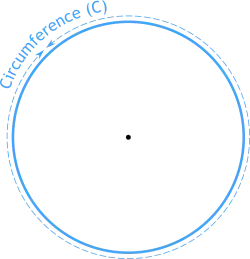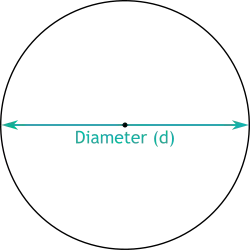Table of contents
Imagine tracing the edge of a perfect circle – that smooth, continuous path that defines its outer boundary. This is the circumference, a fundamental concept in geometry that plays a crucial role in mathematics, engineering, and everyday life. Whether you're a student, professional, or simply curious about mathematical principles, understanding circumference is both practical and fascinating.
How to use our circumference calculator:
Identify which measurement you have: radius (distance from center to edge), diameter (distance all the way across), or area (total space inside).
Select this measurement from the list.
Type your number into the correct field
Check your result! The calculator instantly shows the circumference and other parameters of the circle, as well as the formulas for calculation.
That's it! Our calculator takes care of all the complex math for you. So whether you're measuring a pizza or planning a round garden bed, you'll get the exact circumference you need instantly.
- Since we know the radius - let's select the Radius (r) from the list.
- Type "20" into the Radius (r) box.
- Click the Calculate button.
The calculator will instantly show you the circumference: approximately 125.66 feet.
That's all you need to do! Just make sure your units are set to feet .
What is a circumference?
A circumference is the distance around the outside edge of a circle or any circular object - it's essentially the circle's perimeter.

Think of it like walking around the edge of a round swimming pool - the total distance you'd walk to get back to your starting point is the circumference. Or imagine wrapping a measuring tape around a tree trunk - that measurement would be the tree's circumference.
Some everyday examples to help visualize circumference:
- The distance around the rim of your coffee mug.
- The length around a pizza's edge.
- The distance around a bicycle wheel.
What makes circumference special is that it's always perfectly circular and has a fascinating mathematical relationship with the circle's other measurements. If you measure from the center of the circle to any point on its edge (the radius), this relationship stays constant - it's always 2π (approximately 6.28) times the radius.
This relationship is what makes circles so unique in mathematics and so useful in real life. Whether you're measuring a tiny washer or a massive planetary orbit, the same principles apply - the circumference is always proportional to the size of the circle in exactly the same way.
What is a radius?
The radius of a circle is the distance from the center point to any point on the edge of the circle.

If you stick a pin in the center of a circular piece of paper and tie a string to it, the length of that string when pulled straight to the edge is the radius. No matter which direction you pull the string, as long as it stays straight and reaches the edge, it will always be the same length - that's the radius.
Everyday examples of radius:
- A bike wheel's spoke (from hub to rim).
- The distance from the center of a dartboard to its edge.
- Half the width of a round pizza.
- The length from the center of a round table to its edge.
What is a diameter?
A diameter is the longest straight line that can be drawn through the center of a circle from one edge to the opposite edge.

Think of the diameter as drawing a line that:
- passes through the center point,
- stretches from one side of the circle to the other,
- creates two equal halves of the circle,
- is always twice as long as the radius.
Real-world examples of diameter:
- The width of a pizza measured across its middle.
- The measurement across the face of a clock.
- The distance across a circular pool at its widest point.
What is π?
Earlier we met an obscure symbol π - what is it?
Pi, written as the symbol π (spelled out as "pi"), is approximately 3.14159, though it actually goes on forever without ever repeating. Imagine wrapping a piece of string around any circle and then measuring that string. If you divide that length by the width of the circle (its diameter), you'll always get pi. It doesn't matter if it's a tiny penny or the entire Earth - this relationship stays exactly the same. That's what makes pi so special - it's a constant that appears naturally in our world.
π ≈ 3.14
People have been fascinated by pi for thousands of years. Ancient Egyptians used it to build pyramids, and Babylonians used it to study the stars. Today, scientists and engineers use pi in everything from building bridges to sending rockets into space. It's essential in GPS navigation, computer graphics, and even in predicting river patterns.
Pi is so beloved in the mathematical world that it has its own holiday - Pi Day, celebrated on March 14th (3/14 in the American calendar), where people often celebrate by eating circular pies and solving math puzzles. It's a number that manages to be both practically useful and mysteriously infinite at the same time.
How to find the circumference of a circle
Finding the circumference of a circle isn't as complicated as it might sound. In fact, you probably use this measurement more often than you realize - from wrapping a ribbon around a circular cake to measuring for a new bike tire. Let me show you how to figure it out using simple steps anyone can follow.
If the radius of the circle is given
Sometimes you might only know the radius of your circle (the distance from the center to the edge). No problem! In this case, multiply the radius by 2 to get the diameter, then multiply by pi.
Circumference = 2 × π × r
Or use the shortcut: multiply the radius by 6.28 (which is 2 × 3.14). Let's say you're installing a sprinkler system that needs to reach 10 feet from the center point. The circumference of the watered area would be 62.8 feet (10 × 6.28) - check.
If the diameter of the circle is given
The easiest way to find a circle's circumference is to measure its diameter (the distance straight across the circle through its center) and multiply it by pi (3.14).
Circumference = d × π
That's it! For example, if you have a round table that's 4 feet across, its circumference would be 12.56 feet (4 × 3.14) - check. This tells you exactly how much decorative trim you'd need to go around the edge.
Here's a real-world example that might help: imagine you're making a circular track for a toy train. If the track's diameter is 3 feet, multiply that by 3.14, and you'll find that your train will travel 9.42 feet (check) to complete one lap. Pretty neat, right?
If the area of the circle is given
A circle's area can tell us its circumference - we just need to work backwards through the math! Let's say you have a round tablecloth and know its area, but need to buy trim for the edge. Here's how to find that length: first, divide the area by π (pi), then take the square root of that number. This gives you the radius. Finally, multiply by 2π to get the circumference. The formula looks like this:
Circumference = 2π × √(Area ÷ π)
For example, if your tablecloth has an area of 100 square feet, divide 100 by π (≈31.8), take the square root (≈5.6 feet), and multiply by 2π to get a circumference of about 35.4 feet - check. This works for any circle - from tiny o-rings to giant stadiums.
Circumference formula
FAQ
❓ What is circumference?
Circumference is the distance around a circle - like the length you'd measure if you wrapped a string around the edge of a circular object. Think of it as the perimeter of a circle.
❓ How accurate is this calculator?
Our calculator is accurate to several decimal places. For most everyday uses like measuring a round table or garden bed, two decimal places will be plenty accurate.
❓ What units can I use?
You can use any length unit you like - inches, feet, meters, centimeters, or yards.
❓ Can I find the circumference if I only know the area?
Yes! Enter the area in the area field, and the calculator will work out the circumference. For example, if you know a circular rug covers 100 square feet, the calculator can tell you its circumference.
❓ What's the difference between radius and diameter?
The radius is the distance from the center of the circle to its edge, while the diameter is the full distance across the circle through its center. The diameter is always twice the radius.
❓ What if my measurement isn't exact?
That's okay! Enter your best measurement, and remember that the result will be as accurate as your input. For most practical purposes, being off by a small amount won't matter much.
❓ Can I convert between units?
Our calculator works with any single unit.